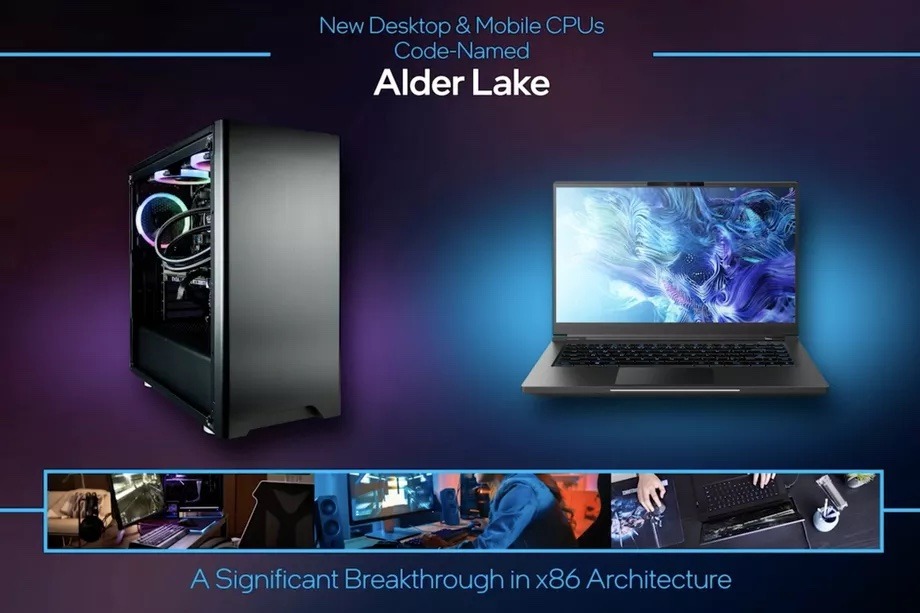During CES 2021, Intel showed off its next-generation Alder Lake family of chips, which the company says offers a "significant breakthrough" for the x86 architecture.
The hybrid Alder Lake chipsets will use a design similar to Apple's M1 chips, incorporating both high-performance and high-efficiency cores in a single package.
That's similar to the "Lakefield" processors that Intel previewed last year. The Alder Lake family, Intel says, will be the foundation for future desktop and mobile processors.
Intel said that the first computers equipped with this "most power-scalable system-on-chip" would debut in the second half of 2021.
 The first computers with Alder Lake chips are set to debut as soon as the second half of 2021. Credit: Intel
The first computers with Alder Lake chips are set to debut as soon as the second half of 2021. Credit: IntelThe 12th-generation Alder Lake chips will feature an "enhanced version" of the 10-nanometer SuperFin designs that have already shown up in Intel's Tiger Lake family. Alder Lake chips will also feature a combination of high-power "Golden Lake" cores and new "Gracemont" power-efficiency cores.
Unlike Intel's past forays into hybrid chips, the company has plans for the Alder Lake family that stretch beyond mobile devices. The move suggests that Intel is taking inspiration from Apple's own silicon success with ARM-based chips.
The announcement comes amid increasing pressure on Intel to explore strategic options in the face of losing its supremacy in the silicon industry.
It isn't clear at this point how many more Macs will use Intel chips going forward. The last time Apple released a macOS device with an Intel chip was the 2020 iMac lineup in August.
The transition to Apple Silicon, which Apple says will take about two years, is already underway. In 2020, Apple released a new Mac mini, MacBook Pro, and MacBook Air devices with proprietary chipsets. In June 2020, however, Apple made mention that it has "some new Intel-based Macs in the pipeline" that have yet to see a release.
 Mike Peterson
Mike Peterson







-m.jpg)






 Charles Martin
Charles Martin


 Malcolm Owen
Malcolm Owen
 William Gallagher
William Gallagher
 Christine McKee
Christine McKee
 Marko Zivkovic
Marko Zivkovic
 Mike Wuerthele
Mike Wuerthele









52 Comments
So they have a CISC architecture that requires more transistors than a RISC design like the M1 and they are using a 10nm process while Apple is already at 5nm. Sounds like a plan.
Too little too late. With all their resources, wtf, why are they so fucking far behind the curve?
This is merely the dying last gasp from a cash cow that became so fat from it’s monopolistic position that it couldn’t move out of its own way.
Now go, you serpent, go tongue kiss and embrace Microsoft goodnight and we’ll all enjoy a double pyrotechnic display unparalleled in the tech world since its Big Bang creation those mere decades ago.
The world will suffer neither of your demises.
Intel’a and TSMC’s nm don’t exactly compare, because they use different processes.
If I remember what seems to be one generation apart, is actually comparable.
So intel’s 10nm is like TSMC’s 7nm
Of course TSMC/Apple already being at 5nm, intel is still one generation behind, they should be at 7nm using their processes, rather than at 10nm
IIRC intel stacks things higher, so they can get similar density with a seemingly one-generation behind process, but they also need comparatively wider traces due to the kind of 3D structure, or something like that. There was an in-depth article on that somewhere, of which I only remember fragments. Point being, intel is behind, but not as much as it seems, but they are being held back by a legacy chip architecture.
Eventually they may just have to do a new RISC architecture, but one designed to run a Rosetta-like software layer for x86 emulation particularly efficiently, i.e. quasi exposing microcode as RISC instruction set...